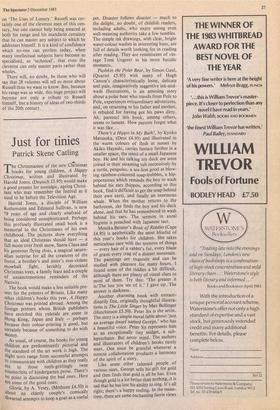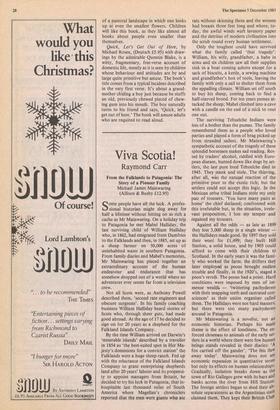Just for tinies
Patrick Skene Catling
The Christmasiest of the new Christmas books for young children, A Happy Christmas, written and illustrated by Harold Jones, (Deutsch £3.95) would make a good present for nostalgic, ageing Christ- ians who may remember the festival as it used to be before the Television Age. Harold Jones, a disciple of William Rothenstein and Edmund Sullivan, is now 79 years of age and clearly unafraid of being considered unsophisticated. Perhaps this profusely illustrated small book is a memorial to the Christmases of his own childhood. The pictures show everything that an ideal Christmas should have — a full moon over fresh snow, Santa Claus and his generous flying elves, a magical saturn- alian surprise for all the creatures of the forest, a brother's and sister's non-violent snowball fight, lavishly decorated Christmas trees, a family feast and a couple of unsanctimonious reminders of the Nativity. The book would make a less suitable pre- sent for the printers of Britain. Like many other children's books this year, A Happy Christmas was printed abroad. Among the foreign printers whom British publishers have enriched this yuletide are some in Hong Kong, Japan and Italy — perhaps because their colour-printing is good, but certainly because of something to do with money.
As usual, of course, the books for young children are predominantly pictorial and the standard of the art work is high. The slight texts range from successful attempts to communicate with children as they really are to those teeth-grittingly twee counterfeits of kindergarten prose. There's no point in discussing the bad ones. Here are some of the good ones: Gloria, by A. Vesey, (Methuen £4.50) is about an elderly couple's comically thwarted attempts to keep a goat as a useful pet. Disaster follows disaster — much to the delight, no doubt, of childish readers, including adults, who enjoy seeing even well-meaning authority take a few tumbles. The simple ink drawings, with clear, bright water-colour washes in interesting hues, are full of details worth looking for in reading after reading. They are reminiscent of vin- tage Tomi Ungerer in his more bucolic moments.
Pushkin the Polar Bear, by Simon Gaul, (Quartet £5.95) with many of Hugh Casson's characteristically loose, delicate and pale, imaginatively suggestive ink-and- wash illustrations, is an amusing story about a polar bear who travels from Pole to Pole, experiences extraordinary adventures, and, on returning to his father and mother, is rebuked for having got his paws dirty. Ah, parents! this book, among others, seems to lament. How parents forget what it was like...
There's a Hippo in My Bath!, by Kyoko Matsuoka, (Dent £4.95) and illustrated in the warm colours of flesh at sunset by Akiko Hayashi, carries fantasy further in a smaller space, the mind of a small Japanese boy. He and his talking toy duck are soon joined in their steaming tub successively by a turtle, penguins, a sea-lion good at blow- ing rainbow-coloured soap-bubbles, a hip- popotamus which reminds the boy to wash behind his ears (hippos, according to this book, find it difficult to get the soap behind their own ears), and finally an enormous whale. When the mother returns to the bathroom, she finds the boy and his duck alone, and that he has remembered to wash behind his ears. The sermon in aural hygiene is preached with Japanese tact. Monika Beisner's Book of Riddles (Cape £4.95) is aesthetically the most blissful of this year's books for children. She takes meticulous care with the textures of things — every hair of a rabbit's fur, every blade of grass, every crag of a distant mountain. The paintings are exquisite and can be studied with pleasure for many hours. I found some of the riddles a bit difficult, although there are plenty of visual clues to most of them. Try this: 'The greater it is/The less you see of it.' I gave up. The answer is darkness. Another charming book with extraor- dinarily fine, originally thoughtful illustra- tions is The Little Singer by Max Bollinger (Hutchinson £5.50). Peter Sis is the artist. The story is a simple moral fable about `just an average dwarf named George,' who has a beautiful voice. Peter Sis represents him as an exceptionally tiny midget, a sub- leprechaun. But never mind. The authors and illustrators of children's books rarely meet. One must be grateful whenever a remote collaboration produces a harmony of the spirit of a story. Like some other talented people of various sizes, George sells his gift for gold and then finds that gold is all he has. Even though gold is a lot better than nothing, it is sad that he has lost his ability to sing. It's all right; there's a happy ending. In the mean- time, there are some enchanting faerie views
of a pastoral landscape in which one looks up at even the smallest flowers. Children will like this book, as they like almost all books about people even smaller than themselves.
Quick, Let's Get Out of Here, by Michael Rosen, (Deutsch £5.95) with draw- ings by the admirable Quentin Blake, is a witty, fragmentary, free-verse account of domestic life, mostly as it is seen by children whose behaviour and attitudes are by and large quite primitive but astute. The book's title comes from a typical incident described in the very first verse. It's about a grand.. mother chiding a boy just because he stuffs an old, previously chewed pieced of chew- ing gum into his mouth. The boy naturally turns to his friend and says, 'Quick, let's get out of here.' The book will amuse adults who are required to read aloud.















































 Previous page
Previous page